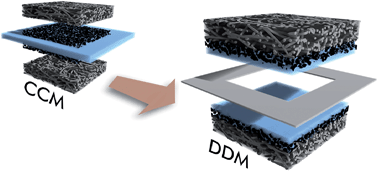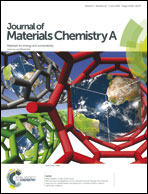Direct deposition of proton exchange membranes enabling high performance hydrogen fuel cells
Abstract
We apply drop-on-demand inkjet printing to fabricate proton exchange membranes for polymer electrolyte fuel cells. This completely substitutes the commonly used membrane foil. A Nafion® dispersion is deposited directly onto the catalyst layers of anode and cathode gas diffusion electrodes, and the two electrodes are pressed together with the membrane layers facing each other. Fuel cells constructed utilizing this method reveal a thin overall membrane thickness of 8–25 μm and a good adhesion of membrane and catalyst layers. This results in a membrane ionic resistance of only 12.7 mΩ cm2 without compromising hydrogen crossover, which was determined to be less than 2 mA cm−2. We achieve a cell power density exceeding 4 W cm−2 with pure oxygen as cathode fuel, which, to our knowledge, is the highest reported power density with a Nafion® membrane hydrogen fuel cell. The membrane shows a stable performance over the entire range of reactant gas humidification from 0 to 100% relative humidity. Power densities exceeding 1.0 W cm−2 are achieved under dry operation with air as cathode fuel. A 576 hour combined mechanical and chemical accelerated stress test reveals no significant degradation in terms of hydrogen crossover, indicating a promising lifetime of the membrane.

- This article is part of the themed collection: 2015 Journal of Materials Chemistry A Hot Papers

 Please wait while we load your content...
Please wait while we load your content...